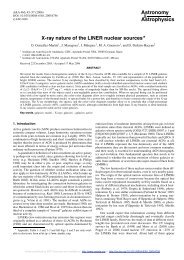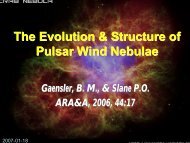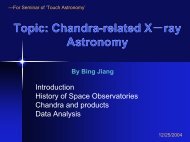The Interactions between the SNRs and Their Environments
The Interactions between the SNRs and Their Environments
The Interactions between the SNRs and Their Environments
You also want an ePaper? Increase the reach of your titles
YUMPU automatically turns print PDFs into web optimized ePapers that Google loves.
<strong>The</strong> <strong>Interactions</strong> <strong>between</strong> <strong>the</strong> <strong>SNRs</strong><br />
<strong>and</strong> <strong>The</strong>ir <strong>Environments</strong><br />
Dissertation committee:<br />
Zigao Dai (NJU)<br />
Yongfeng Huang (NJU)<br />
WenwuTian(CAS-NAO)<br />
Fangjun Lu (CAS-IHEP)<br />
Li Ji (CAS-PMO)<br />
Xin<br />
Zhou<br />
2011 May 18<br />
Supervisors:<br />
Yang Chen (NJU) &<br />
Fabrizio Bocchino (INAF-OAPa)
Forward Shock (FS)<br />
Contact Discontinuity (CD)<br />
Reverse Shock (RS)<br />
SNR Basics<br />
Shocked CSM/ISM<br />
Shocked ejecta<br />
Unshocked ejecta<br />
Pulsar<br />
/PWN<br />
Mixed-Morphology/<br />
<strong>The</strong>rmal Composite
Inhomogeneities<br />
ISM<br />
Asymmetric stellar-wind<br />
(g cm -<br />
ρ<br />
CSM<br />
3 )ρ<br />
of CSM/ISM<br />
Kwok (2007)<br />
Dwarkadas (2007)<br />
p (dyn cm- 2 )ρ
SNR-cloud Interaction<br />
γ-ray source<br />
Wardle & Yusef-Zadeh (2002)<br />
Hydrodynamic evolution<br />
(<strong>The</strong>rmal Conduction)<br />
--<strong>the</strong> Cygnus Loop;<br />
Ionization history<br />
(Over-Ionization)<br />
--W49B;<br />
Molecular chemistry<br />
--Kes 69&W49B;<br />
Hadronic CRs.
<strong>The</strong>rmal Conduction (TC)<br />
Without TC With TC<br />
Orl<strong>and</strong>o et al. (2005)<br />
Stronger transmitted shock;<br />
Weaker reflected shock;<br />
Depress <strong>the</strong> HY instabilities;<br />
Reducing <strong>the</strong> mixing of <strong>the</strong><br />
cloud;<br />
Evaporating <strong>the</strong> cloud<br />
material.<br />
Efficiency of TC in<br />
real case?
Ionization Temp.<br />
Over-Ionization (OI)<br />
Kawasaki et al. (2005)<br />
Ionization Equilibrium<br />
Ozawa et al. (2009)<br />
Origin of OI?<br />
W49B by Suzaku
My Works<br />
• MCs distribution around Kes 69<br />
• SNR-cloudlet interaction in <strong>the</strong> Cygnus Loop<br />
• MCs distribution around W49B; Origin of OI<br />
in W49B<br />
• Conclusions <strong>and</strong> Prospects
Kes<br />
69<br />
4.5 μm & 24 μm<br />
Red:Radio 1.4 GHz<br />
Green:12CO (1-0) 79-82 km/s<br />
White contour:X-ray<br />
•Fast shock ~10 3 km/s, slow shock ~10 km/s;<br />
•Swept up by <strong>the</strong> progenitor’s stellar wind;<br />
•Association with 85 km/s MC<br />
5.2 & 9.6 kpc.
Kes<br />
Galactic latitude<br />
-0:30:00<br />
69 --<br />
HI 21 cm<br />
6.78 km/s<br />
22:00.00 21:40.00<br />
Galactic longitude<br />
•Absorption feature:4, 6, 15, 40, 48, 67, 70, 82, <strong>and</strong> 88 km/s<br />
•No absorption found around tangent point(7.4 kpc <strong>and</strong> 113.7 km/s)<br />
D < 7.4 kpc<br />
T B (K)<br />
D ~ 5.2 kpc, <strong>the</strong>n R ~ 13 pc age ~ 4.4 kyr<br />
e -τ<br />
Velocity (km/s)
<strong>The</strong> Cygnus Loop<br />
XA<br />
region,<br />
observed<br />
by XMM<br />
ROSAT HRI<br />
•Curved shock<br />
front;<br />
•“Dense finger”;<br />
•Clumpy<br />
features with<br />
hot corona;<br />
•Long strip;<br />
•Distribution of<br />
ejecta.
<strong>The</strong> Cygnus Loop --<br />
•Abundance of shocked<br />
ISM is low;<br />
•Hot component in<br />
regions 4 <strong>and</strong> 9 mainly<br />
originate from ejecta;<br />
•T ejecta >T ISM .<br />
Spectral Analysis:<br />
Region 1<br />
Region 9
<strong>The</strong> Cygnus Loop --<br />
•Flatter slopes (> -0.45);<br />
•Region 7&8: Less efficient TC;<br />
•Region 3&4: ejecta<br />
ascending trend<br />
Role of TC<br />
TC is predominant in<br />
all of <strong>the</strong> shock-cloud<br />
interaction regions.
W49B --<br />
Multib<strong>and</strong><br />
X-ray jet-like feature + sharp shell<br />
Near-IR + Mid-IR + Radio loops<br />
Molecular shell<br />
Observations<br />
Credit: X-ray: NASA/CXC/SSC/J. Keohane et al.;<br />
Infrared: Caltech/SSC/J.Rho <strong>and</strong> T. Jarrett<br />
Red: 2.12 micron molecular hydrogen<br />
Green: 1.64 micron [FeII]<br />
Blue: Ch<strong>and</strong>ra X-ray<br />
Radio continuum<br />
Lacey et al. (2001)<br />
by Zhou<br />
mid-IR
W49B --<br />
CO (1-0)<br />
CO (2-1)<br />
CO Observations<br />
v LSR (km/s)<br />
SMT SRAO<br />
Point L2<br />
Point R1<br />
Probably associated with 40 km/s MC<br />
D ~ 2.3 & 9.3 kpc<br />
CO (1-0)<br />
CO (2-1)
T B (K)<br />
W49B --<br />
e -τ<br />
HI 21 cm<br />
Velocity (km/s)<br />
•Absorption feature:7,16, 20, 35, 40, 52, 60, <strong>and</strong> 70 km/s<br />
•<strong>The</strong>re is absorption feature around tangent point(at ~71.7 km/s)<br />
D > 5.8 kpc<br />
•No absorption feature at 12 km/s<br />
D < 11.1 kpc<br />
D ~ 9.3kpc
W49B --<br />
Model<br />
Red: 2.12 micron molecular hydrogen<br />
Green: 1.64 micron [FeII]<br />
Blue: Ch<strong>and</strong>ra X-ray<br />
east<br />
west<br />
Credit: X-ray: NASA/CXC/SSC/J. Keohane et al.;<br />
Infrared: Caltech/SSC/J.Rho <strong>and</strong> T. Jarrett
W49B --<br />
Model<br />
Fluid equations of mass, momentum,<br />
<strong>and</strong> energy conservation:<br />
<strong>The</strong>rmal conduction (both classical<br />
<strong>and</strong> saturated considered):<br />
Continuity equations for each ion<br />
species:<br />
represents <strong>the</strong> collisional <strong>and</strong> dielectronic<br />
recombination coeffecients, <strong>and</strong> represents<br />
<strong>the</strong> collisional ionization coefficients.
W49B --<br />
Simulation Results<br />
Density Temperature<br />
Ionization<br />
equilibrium<br />
underionization overionization near<br />
ionization<br />
equilibrium
W49B --<br />
Simulation Results<br />
Miceli et al. (2010)<br />
Zhou et al. (2010)
Conclusions:<br />
<strong>The</strong>rmal conduction is important to underst<strong>and</strong> <strong>the</strong> hydrodynamic evolution<br />
of shock-cloud interaction;<br />
<strong>The</strong> jet-like feature in SNR could be a hydrodynamical effect;<br />
<strong>The</strong> overionization effect could be understood in <strong>the</strong> shock-cloud<br />
interaction process;<br />
<strong>The</strong> distribution of MCs around <strong>SNRs</strong> could be greatly affected by <strong>the</strong><br />
progenitor’s stellar-wind.
Brief Summary:<br />
Associated 85 km/s MC shell in Kes 69 as <strong>the</strong> remnant of <strong>the</strong> progenitor's<br />
stellar wind, two types of shock, d~5.2kpc, t age~4.4 kyr;<br />
In <strong>the</strong> XA region of <strong>the</strong> Cygnus Loop, <strong>the</strong> shock is interacting with dense<br />
<strong>and</strong> clumpy ISM, <strong>and</strong> <strong>the</strong>re is a long bent “finger” protruding into <strong>the</strong><br />
remnant, TC is important in <strong>the</strong> shock-cloud interactions,<strong>the</strong> abundance of<br />
<strong>the</strong> surrounding ISM is lower than solar value;<br />
Probable associated semi-circular 40 km/s MC in W49B as <strong>the</strong> remnant of<br />
<strong>the</strong> progenitor's stellar wind, d~9.3 kpc, <strong>the</strong> numerical model provides us<br />
explanations of <strong>the</strong> origins of X-ray morphology <strong>and</strong> overionized plasma,<br />
t age~2.3kyr.
Prospects:<br />
<strong>The</strong> emissions of NEI plasma need to be examined;<br />
To underst<strong>and</strong> <strong>the</strong> SNR-MC interactions, detailed model of molecular<br />
reactions is needed.<br />
• <strong>The</strong> structure of <strong>the</strong> ISM<br />
• Origin of <strong>SNRs</strong> with peculiar morphology<br />
• CRs in SNR
Refereed papers<br />
Publications:<br />
1.Zhou, X., Miceli, M., Bocchino, F., Orl<strong>and</strong>o, S., <strong>and</strong> Chen, Y. 2011, MNRAS, in<br />
Press (arXiv: 1103.2290)<br />
2.Su, Y., Chen, Y., Yang, J., Koo, B. C., Zhou, X., Lu, D. R., Jeong, I. G., <strong>and</strong><br />
DeLaney, T. 2010, ApJ, 727, 43<br />
3.Zhou, X., Bocchino, F., Miceli, M., Orl<strong>and</strong>o, S., <strong>and</strong> Chen, Y. 2010, MNRAS,<br />
406, 223<br />
4.Jiang, B., Chen, Y., Wang, J. Z., Su, Y., Zhou, X., Safi-Harb, S., <strong>and</strong> DeLaney, T.<br />
2010, ApJ, 712, 1147<br />
5.Orl<strong>and</strong>o, S., Bocchino, F., Miceli, M., Zhou, X., Reale, F., <strong>and</strong> Peres, G. 2010,<br />
A&A, 514,290<br />
6.Su, Y., Chen, Y., Yang, J., Koo, B. C., Zhou, X., Jeong, I. G., <strong>and</strong> Zhang, C. G.<br />
2009, ApJ, 694, 376<br />
7.Zhou, X. , Chen, Y., Su, Y., <strong>and</strong> Yang, J. 2009, ApJ, 691, 516
















